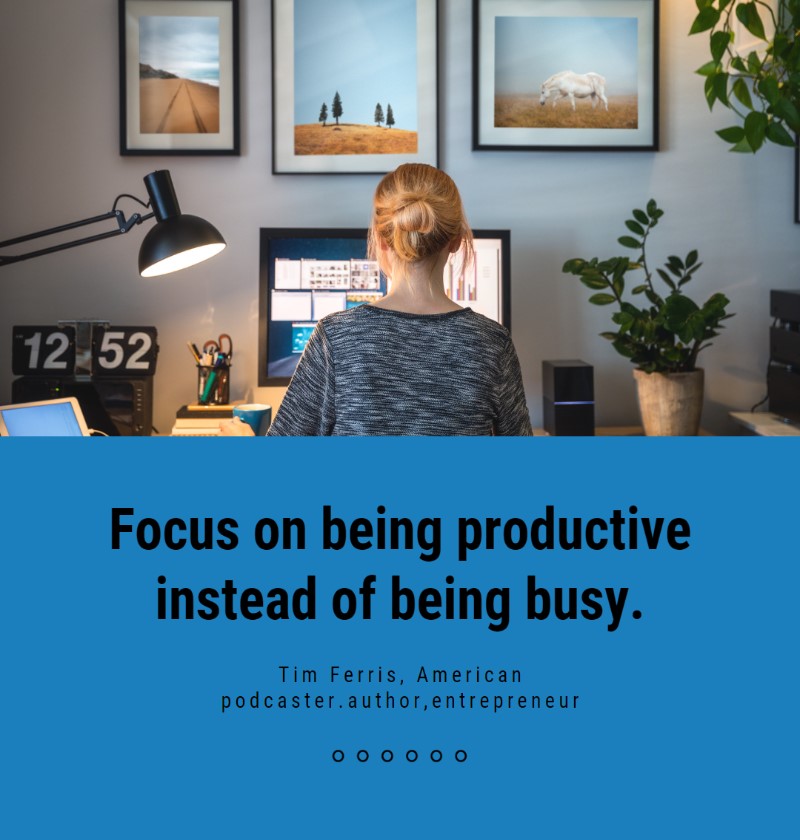As a solopreneur, there is a lot to keep track of and manage on a daily, weekly, and ongoing basis. From setting and achieving goals to managing finances and handling daily tasks, it’s challenging. At times, you may think you’re not being as productive as you could be.
Would you like to boost your productivity and take your business to the next level? If your answer is yes, then the following suggestions are for you. Working productively and effectively is possible. If you use one or more of the following ideas, you will have a whole new way of thinking about how to run your business efficiently.
I. Focus on Single-Tasking 
If you are like me, you have met people who seem to be able to do numerous tasks all at once. They appear to be superhuman. However, did you know that the idea of multitasking is really a misnomer?
According to Sharon Salzberg, the “brain can focus only on one thing at a time. We take in information sequentially. When we attempt to focus on multiple tasks simultaneously, what actually happens is that we switch back and forth between tasks, paying less attention to both. This does not mean that we can’t walk and chew gum at the same time, of course. What we cannot do is concentrate in the same moment on two distinct, input-rich activities that require our attention.”
Having read numerous articles on the subject, it is clear that single-tasking is the way to go. Single-tasking has benefits.
Multitasking is detrimental to productivity. First, multitasking can lead to a decrease in productivity. As we read above, it’s difficult to switch attention between tasks as it takes time to get into the flow of each task. Furthermore, switching your attention between tasks can cause mental fatigue. This makes it harder to complete each task to a high standard. In addition, multitasking can also lead to an increase in errors and mistakes. As a result one feels overwhelmed and stressed..
Benefits of Single-Tasking
On the other hand, single-tasking is quite the opposite. First, when you focus on one task at a time, you are able to give it your full attention. As a result, you complete it more quickly and efficiently. Secondly, single-tasking allows you to be more present and mindful in the moment. This can lead to better focus, concentration, and creativity. Finally, single-tasking can help reduce stress as you are not constantly trying to juggle multiple tasks and deadlines.
It’s important to note that there are certain tasks that can be done simultaneously. Listening to music while doing paperwork is one example. It doesn’t require a lot of cognitive resources. However, it’s important to be aware of the cognitive load of each task and prioritize accordingly.
How To Single-Task
You might be thinking, “But, I have too many things that need to get done today, how can I only focus on one?” Well, the answer is simple. Make a To-Do list before deciding which single item you should work on. Some folks do this at the start of their day. I prefer the end of the day. My reason for doing this will become clear shortly.
Once you have your to-do list in front of you, identify your most important task. This is usually based on the level of urgency and importance. Then, you can follow these steps to complete that single task:
Step 1: Remove Distractions. Find and get rid of any things that might keep you from concentrating on the task at hand. This may include turning off your phone, closing unnecessary tabs on your computer, and finding a quiet space to work.
Step 2: Set a timer. Set a timer for a specific amount of time, such as 25 minutes, to stay focused on the task at hand. This is known as the Pomodoro Technique.
Step 3: Focus on the task. Once the timer starts, focus all of your attention on the task at hand and avoid any other distractions.
Step 4: Take a break. When the timer goes off, take a short break before starting the next task.
Step 5: Repeat Go through the process again for each task on your to-do list.
Step 6: Reflect. At the end of the day, you can reflect on your progress. Ask yourself how you felt about the process and if you could have improved on anything. At this point, I either make a new To-Do list for the following day or simply check off the items that I was able to complete. I then have my list ready for the start of my new day.
Some people find that they become discouraged if they have not completed more than one item on their list. But keep in mind that working diligently to complete or make progress on the one item you deem most important is preferable to completing multiple tasks half-heartedly.
By following this outline, you can train yourself to focus on one task at a time. This increases your productivity and quality of work. Be mindful that it’s a process, and you will improve with time. The most important thing is to be consistent.
II. Outsource
Outsourcing means hiring external help for various tasks. Often, these tasks are those that you either dislike or do not have expertise in. By outsourcing, you free up time and resources to focus on core business activities and grow the business.
A solopreneur may choose to outsource a variety of tasks depending on their specific business needs, goals, and personal weaknesses. Some common tasks that solopreneurs may outsource include:
- Administrative tasks such as bookkeeping, accounting, and data entry.
- Marketing and advertising like creating and managing social media campaigns, designing marketing materials, and running Google AdWords campaigns.
- Technical tasks including website development, programming, and IT support.
- Creative tasks such as graphic design, copywriting, and video production.
- Customer service and support like responding to customer inquiries and managing online reviews.
- Business development tasks namely lead generation, sales, and market research.
It’s important to note that outsourcing should be done strategically. The reason being that it involves not only cost but also quality, speed, and other factors that can impact the business. Also, as a solopreneur, it’s important to know about the legal and financial aspects of outsourcing, like contracts, taxes, and compliance.
If you are starting out as a solopreneur, you may not be in a position financially to outsource. However, regardless of your financial position, you also want to be mindful of your finances. As such, rather than outsourcing, a solopreneur can also consider leveraging the various tools available. These are numerous and will make one’s time and focus productive.
III. Leverage Tools and Automation
There are numerous digital tools that can lend a hand to the solopreneur. In fact, some of them are even free! Below is a general list of some of the tools available.
- Project management tools such as Asana, Trello, or Monday.com, which help you keep track of tasks, deadlines, and team members.
- Communication tools like Slack, Zoom, or Microsoft Teams, which allow you to collaborate with team members, partners, and customers.
- Accounting and invoicing tools namely Pro-Ledger Online, QuickBooks, Xero, or Wave, which automate financial tasks such as invoicing, expense tracking, and tax preparation.
- Marketing and advertising tools such as Hootsuite, Mailchimp, or Canva, which help you create and manage social media campaigns, design marketing materials, and run online ads.
- E-commerce platforms like Shopify, BigCommerce, or WooCommerce, which allow you to set up an online store and sell products or services.
- Time-tracking and productivity tools such as RescueTime, Toggl or Focus@Will, which helps you monitor your time usage, set goals and focus on your work.
- Customer Relationship Management (CRM) tools like Salesforce, Hubspot, or Pipedrive, which can help you manage and analyze customer interactions and data.
- Analytics and reporting tools including Google Analytics, SEMrush, or Ahrefs, which can help you track website traffic, measure marketing performance and conduct competitor research.
These are just a few examples of the many digital tools available to solopreneurs. It’s important to evaluate your specific business needs. Choose only the tools that will best support your goals and objectives.
I’ve outlined 5 apps that I believe are useful to every solopreneur, regardless of their niche. You can read about them in What Technology Solopreneurs Need to Thrive and Succeed.
Be mindful that initially, it will take time to learn how to use the tools you select. However, once you are over the initial learning curve, you will be glad you implemented them. Your productivity will definitely increase.
IV. Jump To It
One of the biggest hindrances to productivity is procrastination. I’m sure we’ve all been there. People procrastinate for a variety of reasons. Some are afraid of failure, while others are perfectionists and do not want to make mistakes. It’s important to note that procrastination is not a problem that is exclusive to one group of people. This can happen to anyone, and it can be overcome with the right strategies.
Some of these strategies are:
- Setting specific and realistic goals
- Breaking tasks into manageable chunks
- Setting deadlines
- Eliminating distractions.
According to Christoph Filgertshofer, “The ‘big monster’ that is procrastination isn’t as hard to conquer as one might think. Of course, it’s always easier said than done, but my biggest tip when conquering tasks that seem too big or too far away is to just start it. Do it now.”
V. Eliminate Distractions
Eliminating distractions while working is crucial for productivity and focus. The following are a few ideas on how you can accomplish this:
- Dedicated Workspace
One way to do this is by creating a dedicated workspace. This is especially true if you are working at home. From home, a person might be tempted to work from the couch or a reclining lazy chair. But it’s a sure thing that this won’t be as productive as working in an “office.”
The psychological impact of designating a physical space as an office or work area is significant. It signals to your brain that it is time to get to work and shifts your energy level into business mode. Ideally, your workspace will be a separate room in the house with a door to open at the beginning of your workday and to close at the end. However, this may not be possible for you. One solution might be to purchase a decorative room divider.
Wherever you decide to work in your home, be consistent, make sure it is quiet (if necessary, purchase noise-canceling headphones), and be sure to have the items I mentioned above and fresh air if possible. Also, make sure it is free of TV, social media notifications, and other electronic devices that could be a distraction.
2. Create a Schedule
Another way to eliminate distractions is to set specific working hours and stick to them. When deciding this, be sure that you consider your own work rhythm and plan your schedule accordingly. In other words, become familiar with your natural cycle and work around it as much as possible. We all have a peak, a valley, and a rebound time in our day. The important thing to discover is what time of day you are most productive.
3. Prioritize Tasks
As discussed earlier, creating a to-do list and prioritizing tasks will enable you to be more productive.
4. Take Breaks
It’s also important to take regular breaks. Taking regular breaks can help increase productivity by giving the brain a chance to rest and recharge. When we work for long periods of time without a break, we can become mentally fatigued. This can lead to decreased focus, increased errors, and a general reduction in productivity. By taking a break, even for just a few minutes, we allow our brains to relax. In turn, we can improve our focus and concentration when we return to work.
Additionally, taking breaks can also help prevent burnout. This is a state of emotional, mental, and physical exhaustion caused by prolonged stress. In summary, taking breaks throughout the day can help boost productivity by allowing the brain to rest, recharge, and prevent burnout.
5. Learn to Say NO!
It’s important to learn to say “no.” This is an important aspect of increasing productivity. Saying “yes” to every task or request can lead to overcommitting and becoming overwhelmed. The result is decreased productivity and possibly burnout.
By learning to say “no” to non-essential tasks or requests, you can focus on the most important and urgent tasks. As a result, you will work more efficiently and effectively.
Additionally, saying “no” can also help you set boundaries and prioritize self-care. These are both essential for maintaining a healthy work-life balance.
In order to increase productivity, one needs to be proactive. If you take the initiative and work to put one or more of the above suggestions into action, productivity will definitely go up. Initially, it may take more of your time as you adjust your practices. However, in the long run, you will reap great rewards.
Pro Ledger Online offers a cloud-based bookkeeping solution for small business professionals. Click here for a 30-day free trial. – www.pro-ledger.com “Bookkeeping Made Simple”




